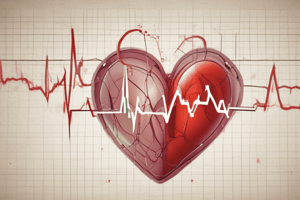Podcast
Questions and Answers
What is the most accurate method of determining heart rate with a regular rhythm from the ECG rhythm strip?
What is the most accurate method of determining heart rate with a regular rhythm from the ECG rhythm strip?
- Counting the number of RR intervals in 6 seconds and multiplying that number by 10
- Counting the number of small boxes within an RR interval and dividing 1500 by that number (correct)
- Using the top of the ECG paper to mark 3-second intervals
- Counting the number of large boxes within an RR interval and dividing 300 by that number
How can heart rate be estimated when the rhythm is irregular?
How can heart rate be estimated when the rhythm is irregular?
- Using the top of the ECG paper to mark 3-second intervals
- Counting the number of large boxes within an RR interval and dividing 300 by that number
- Counting the number of small boxes within an RR interval and dividing 1500 by that number
- Counting the number of RR intervals in 6 seconds and multiplying that number by 10 (correct)
What is the purpose of analyzing the ECG rhythm strip?
What is the purpose of analyzing the ECG rhythm strip?
- To detect arrhythmias and conduction disorders (correct)
- To determine the patient’s blood pressure
- To measure the oxygen saturation level
- To assess the patient's respiratory rate
How many large boxes are there in a 1-minute rhythm strip?
How many large boxes are there in a 1-minute rhythm strip?
What is the alternative method for estimating heart rate?
What is the alternative method for estimating heart rate?
What does counting the number of small boxes within an RR interval help determine?
What does counting the number of small boxes within an RR interval help determine?
Why is it important to analyze the ECG rhythm strip?
Why is it important to analyze the ECG rhythm strip?
What are RR intervals used for in heart rate monitoring?
What are RR intervals used for in heart rate monitoring?
How can atrial rate be determined?
How can atrial rate be determined?
What can excessive insignificant alarms from continuous cardiac monitoring lead to?
What can excessive insignificant alarms from continuous cardiac monitoring lead to?
What does a normal sinus rhythm indicate?
What does a normal sinus rhythm indicate?
What is the purpose of an EKG/ECG for nurses and medical professionals?
What is the purpose of an EKG/ECG for nurses and medical professionals?
What does a normal heart rhythm consist of?
What does a normal heart rhythm consist of?
What does the PR interval measure?
What does the PR interval measure?
What does the QT interval represent?
What does the QT interval represent?
What does the ST segment trace?
What does the ST segment trace?
Why is it important to accurately interpret the components of an EKG/ECG?
Why is it important to accurately interpret the components of an EKG/ECG?
Flashcards are hidden until you start studying
Study Notes
- RR intervals are used for heart rate monitoring instead of QRS complexes to avoid inaccurately high heart rate calculations.
- Atrial rate can be determined using PP intervals.
- Continuous cardiac monitoring can alert healthcare personnel of clinically significant rhythm changes, but excessive insignificant alarms can lead to alarm fatigue.
- Normal sinus rhythm is characterized by a regular rate and rhythm beginning in the SA node, normal QRS shape and duration, a consistent P wave shape and interval, and a 1:1 P:QRS ratio.
- Normal sinus rhythm is indicative of good cardiovascular health but an increased resting heart rate can increase the risk for various cardiac conditions.
- An EKG/ECG is a visual representation of the heart's electrical conduction, and understanding its components is crucial for nurses and medical professionals to identify cardiac diseases early.
- A normal heart rhythm consists of a P wave, QRS complex, and T wave, and accurately interpreting their amplitude, deflection, and duration is essential.
- The PR interval measures atrioventricular conduction time, and the QRS complex indicates ventricular depolarization.
- The QT interval represents ventricular activity, including both depolarization and repolarization, and the ST segment traces the early part of ventricular repolarization.
Studying That Suits You
Use AI to generate personalized quizzes and flashcards to suit your learning preferences.





